Australia's Healthcare System: A Critical Evaluation of Sustainability
VerifiedAdded on 2023/06/04
|20
|5003
|296
Report
AI Summary
This report critically evaluates the sustainability of Australia's healthcare system, which has adopted a value-based healthcare reform model. It examines the shift from traditional volume-based measurements to valuing health outcomes, patient experience, and efficient care in relation to costs. The report addresses challenges such as rising costs, increased demand, and technological advancements, particularly concerning the aging population and the prevalence of chronic diseases. It further discusses key principles guiding healthcare delivery reform in the United States, including continuous and affordable healthcare coverage, restructured delivery systems promoting health and disease prevention, equitable and sustainable healthcare mechanisms, and adequate healthcare practitioner supply. The report also emphasizes the importance of supporting health research and technological development. Recommendations are provided to address the challenges posed by the aging population, chronic diseases, rising technology costs, and overall demand, aiming to improve the sustainability of the healthcare system and ensure access to quality health services.
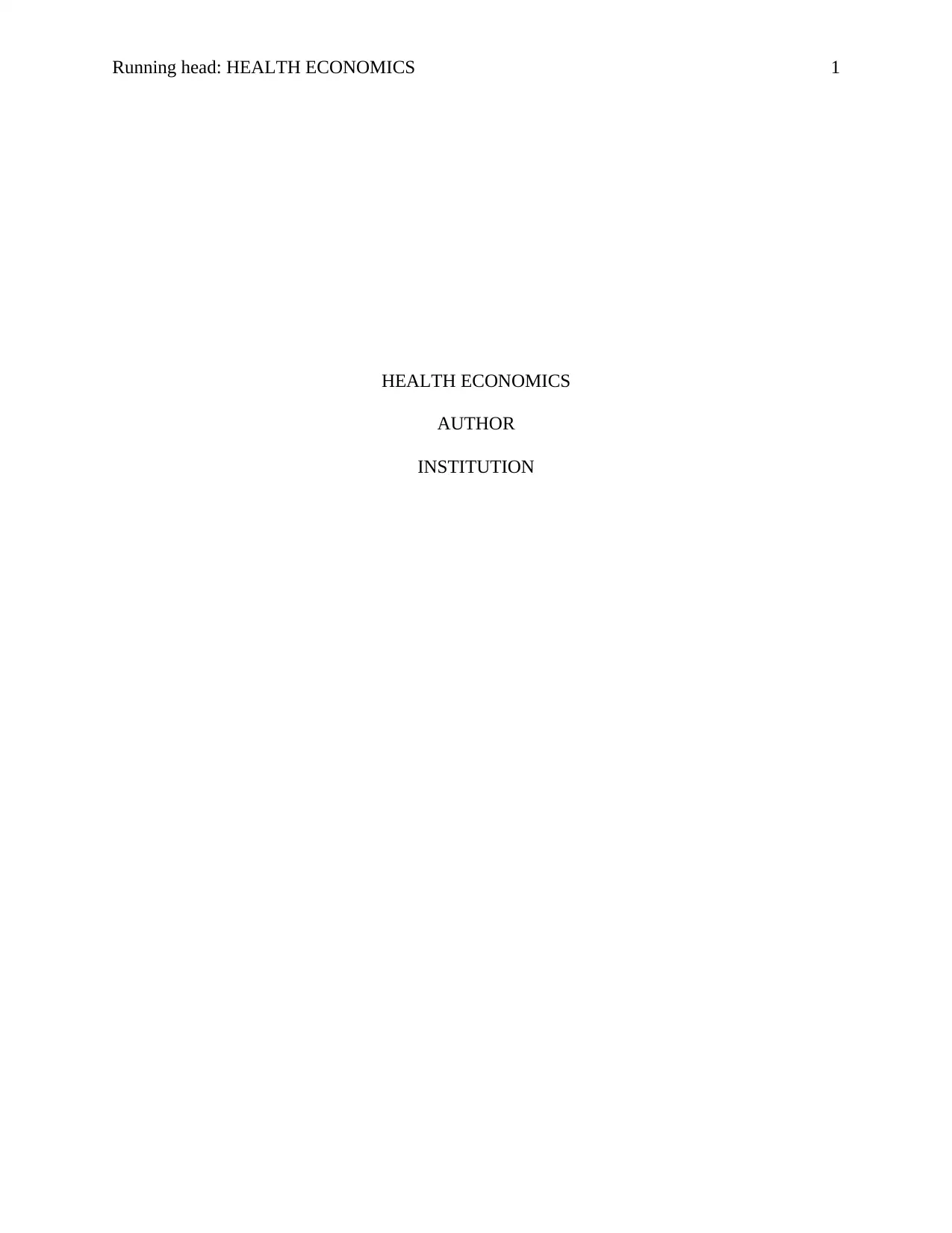
Running head: HEALTH ECONOMICS 1
HEALTH ECONOMICS
AUTHOR
INSTITUTION
HEALTH ECONOMICS
AUTHOR
INSTITUTION
Paraphrase This Document
Need a fresh take? Get an instant paraphrase of this document with our AI Paraphraser
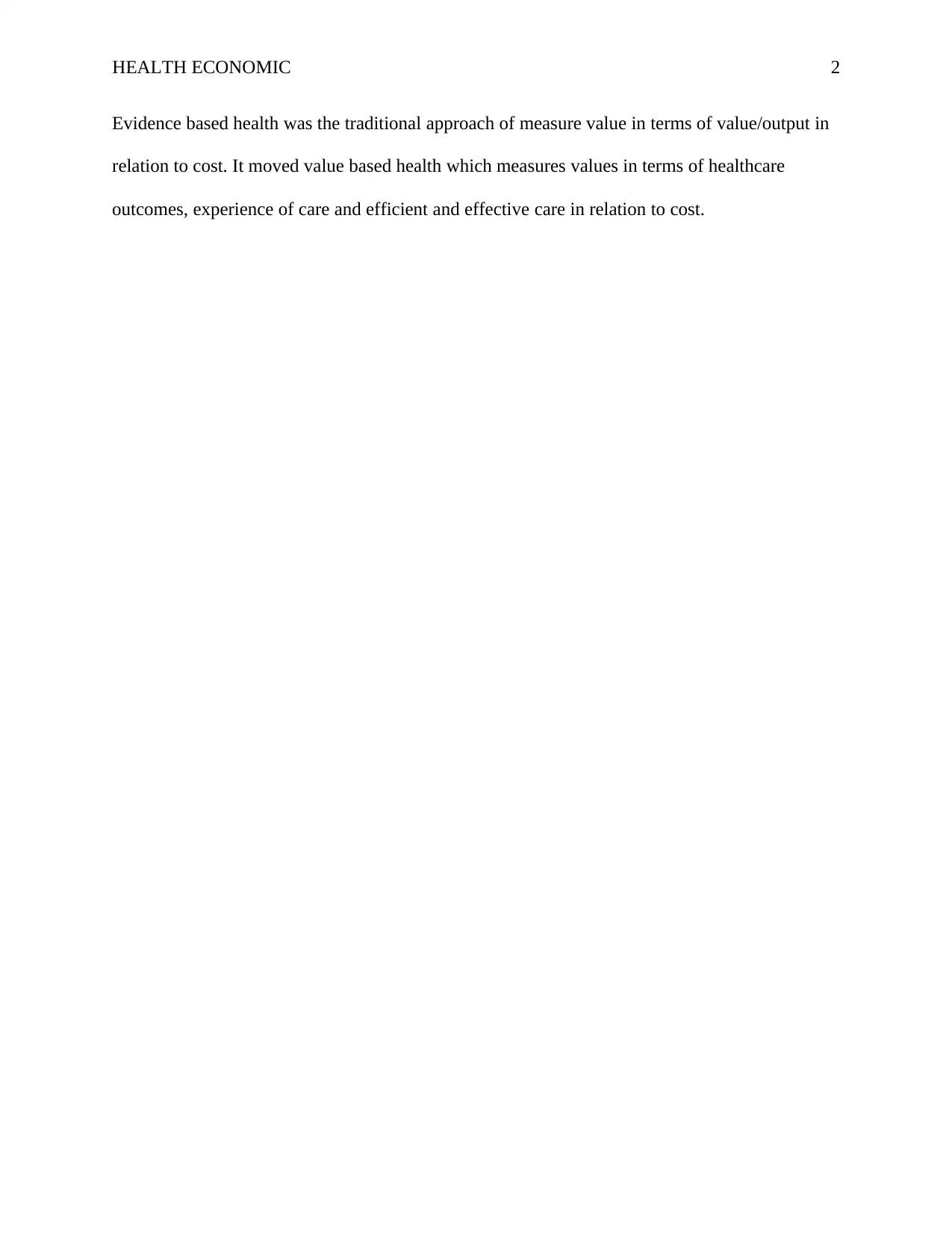
HEALTH ECONOMIC 2
Evidence based health was the traditional approach of measure value in terms of value/output in
relation to cost. It moved value based health which measures values in terms of healthcare
outcomes, experience of care and efficient and effective care in relation to cost.
Evidence based health was the traditional approach of measure value in terms of value/output in
relation to cost. It moved value based health which measures values in terms of healthcare
outcomes, experience of care and efficient and effective care in relation to cost.
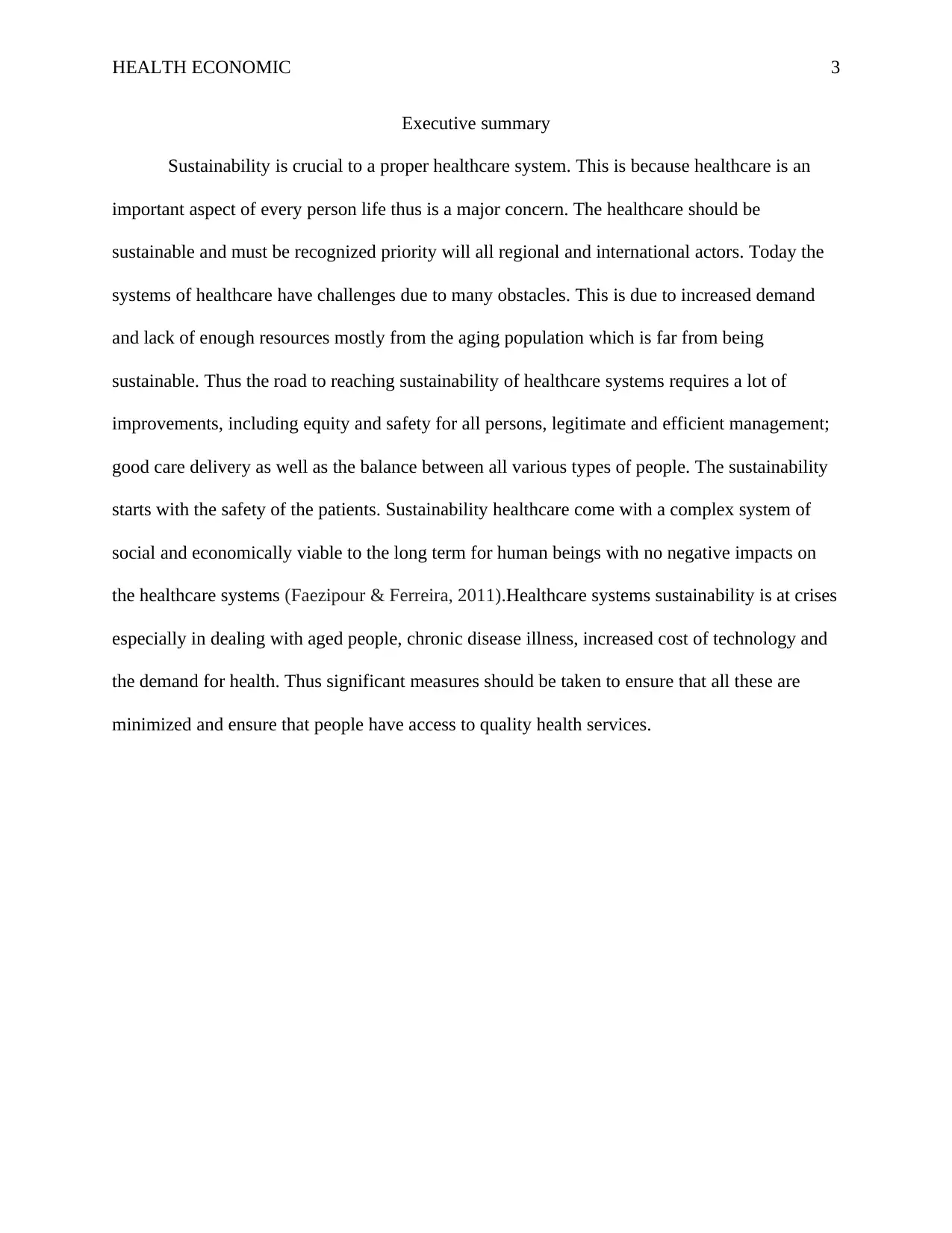
HEALTH ECONOMIC 3
Executive summary
Sustainability is crucial to a proper healthcare system. This is because healthcare is an
important aspect of every person life thus is a major concern. The healthcare should be
sustainable and must be recognized priority will all regional and international actors. Today the
systems of healthcare have challenges due to many obstacles. This is due to increased demand
and lack of enough resources mostly from the aging population which is far from being
sustainable. Thus the road to reaching sustainability of healthcare systems requires a lot of
improvements, including equity and safety for all persons, legitimate and efficient management;
good care delivery as well as the balance between all various types of people. The sustainability
starts with the safety of the patients. Sustainability healthcare come with a complex system of
social and economically viable to the long term for human beings with no negative impacts on
the healthcare systems (Faezipour & Ferreira, 2011).Healthcare systems sustainability is at crises
especially in dealing with aged people, chronic disease illness, increased cost of technology and
the demand for health. Thus significant measures should be taken to ensure that all these are
minimized and ensure that people have access to quality health services.
Executive summary
Sustainability is crucial to a proper healthcare system. This is because healthcare is an
important aspect of every person life thus is a major concern. The healthcare should be
sustainable and must be recognized priority will all regional and international actors. Today the
systems of healthcare have challenges due to many obstacles. This is due to increased demand
and lack of enough resources mostly from the aging population which is far from being
sustainable. Thus the road to reaching sustainability of healthcare systems requires a lot of
improvements, including equity and safety for all persons, legitimate and efficient management;
good care delivery as well as the balance between all various types of people. The sustainability
starts with the safety of the patients. Sustainability healthcare come with a complex system of
social and economically viable to the long term for human beings with no negative impacts on
the healthcare systems (Faezipour & Ferreira, 2011).Healthcare systems sustainability is at crises
especially in dealing with aged people, chronic disease illness, increased cost of technology and
the demand for health. Thus significant measures should be taken to ensure that all these are
minimized and ensure that people have access to quality health services.
⊘ This is a preview!⊘
Do you want full access?
Subscribe today to unlock all pages.

Trusted by 1+ million students worldwide
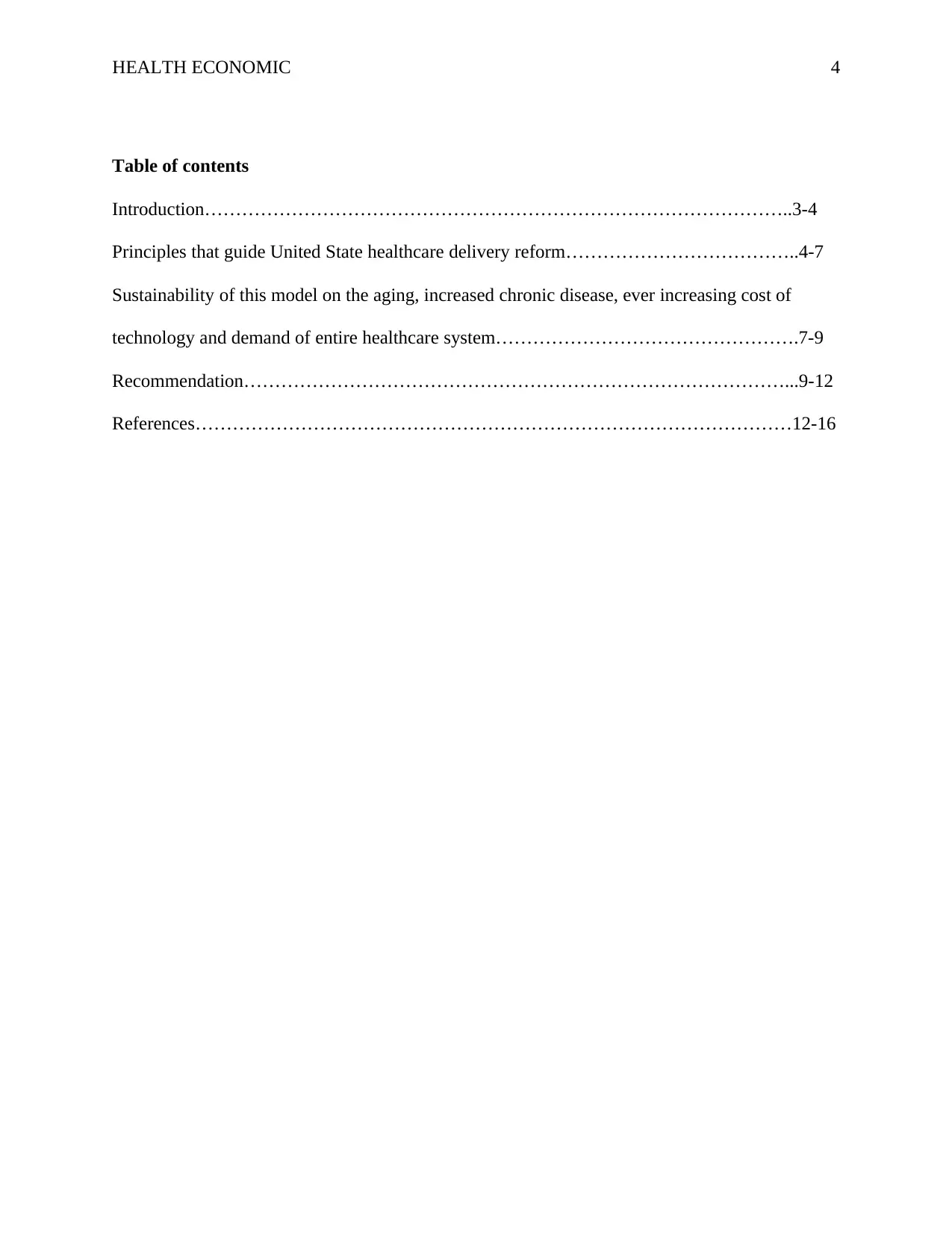
HEALTH ECONOMIC 4
Table of contents
Introduction…………………………………………………………………………………..3-4
Principles that guide United State healthcare delivery reform………………………………..4-7
Sustainability of this model on the aging, increased chronic disease, ever increasing cost of
technology and demand of entire healthcare system………………………………………….7-9
Recommendation……………………………………………………………………………...9-12
References……………………………………………………………………………………12-16
Table of contents
Introduction…………………………………………………………………………………..3-4
Principles that guide United State healthcare delivery reform………………………………..4-7
Sustainability of this model on the aging, increased chronic disease, ever increasing cost of
technology and demand of entire healthcare system………………………………………….7-9
Recommendation……………………………………………………………………………...9-12
References……………………………………………………………………………………12-16
Paraphrase This Document
Need a fresh take? Get an instant paraphrase of this document with our AI Paraphraser
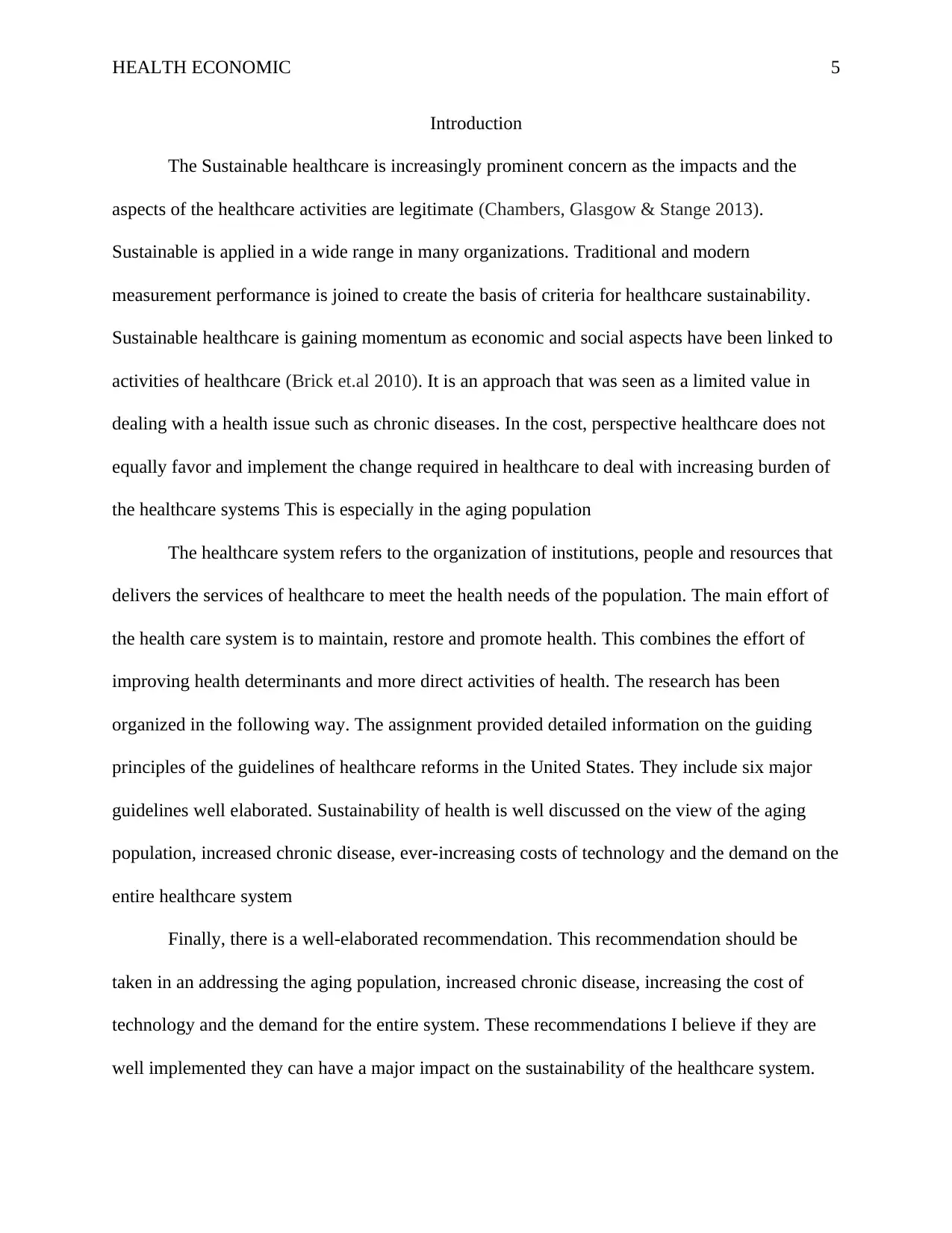
HEALTH ECONOMIC 5
Introduction
The Sustainable healthcare is increasingly prominent concern as the impacts and the
aspects of the healthcare activities are legitimate (Chambers, Glasgow & Stange 2013).
Sustainable is applied in a wide range in many organizations. Traditional and modern
measurement performance is joined to create the basis of criteria for healthcare sustainability.
Sustainable healthcare is gaining momentum as economic and social aspects have been linked to
activities of healthcare (Brick et.al 2010). It is an approach that was seen as a limited value in
dealing with a health issue such as chronic diseases. In the cost, perspective healthcare does not
equally favor and implement the change required in healthcare to deal with increasing burden of
the healthcare systems This is especially in the aging population
The healthcare system refers to the organization of institutions, people and resources that
delivers the services of healthcare to meet the health needs of the population. The main effort of
the health care system is to maintain, restore and promote health. This combines the effort of
improving health determinants and more direct activities of health. The research has been
organized in the following way. The assignment provided detailed information on the guiding
principles of the guidelines of healthcare reforms in the United States. They include six major
guidelines well elaborated. Sustainability of health is well discussed on the view of the aging
population, increased chronic disease, ever-increasing costs of technology and the demand on the
entire healthcare system
Finally, there is a well-elaborated recommendation. This recommendation should be
taken in an addressing the aging population, increased chronic disease, increasing the cost of
technology and the demand for the entire system. These recommendations I believe if they are
well implemented they can have a major impact on the sustainability of the healthcare system.
Introduction
The Sustainable healthcare is increasingly prominent concern as the impacts and the
aspects of the healthcare activities are legitimate (Chambers, Glasgow & Stange 2013).
Sustainable is applied in a wide range in many organizations. Traditional and modern
measurement performance is joined to create the basis of criteria for healthcare sustainability.
Sustainable healthcare is gaining momentum as economic and social aspects have been linked to
activities of healthcare (Brick et.al 2010). It is an approach that was seen as a limited value in
dealing with a health issue such as chronic diseases. In the cost, perspective healthcare does not
equally favor and implement the change required in healthcare to deal with increasing burden of
the healthcare systems This is especially in the aging population
The healthcare system refers to the organization of institutions, people and resources that
delivers the services of healthcare to meet the health needs of the population. The main effort of
the health care system is to maintain, restore and promote health. This combines the effort of
improving health determinants and more direct activities of health. The research has been
organized in the following way. The assignment provided detailed information on the guiding
principles of the guidelines of healthcare reforms in the United States. They include six major
guidelines well elaborated. Sustainability of health is well discussed on the view of the aging
population, increased chronic disease, ever-increasing costs of technology and the demand on the
entire healthcare system
Finally, there is a well-elaborated recommendation. This recommendation should be
taken in an addressing the aging population, increased chronic disease, increasing the cost of
technology and the demand for the entire system. These recommendations I believe if they are
well implemented they can have a major impact on the sustainability of the healthcare system.
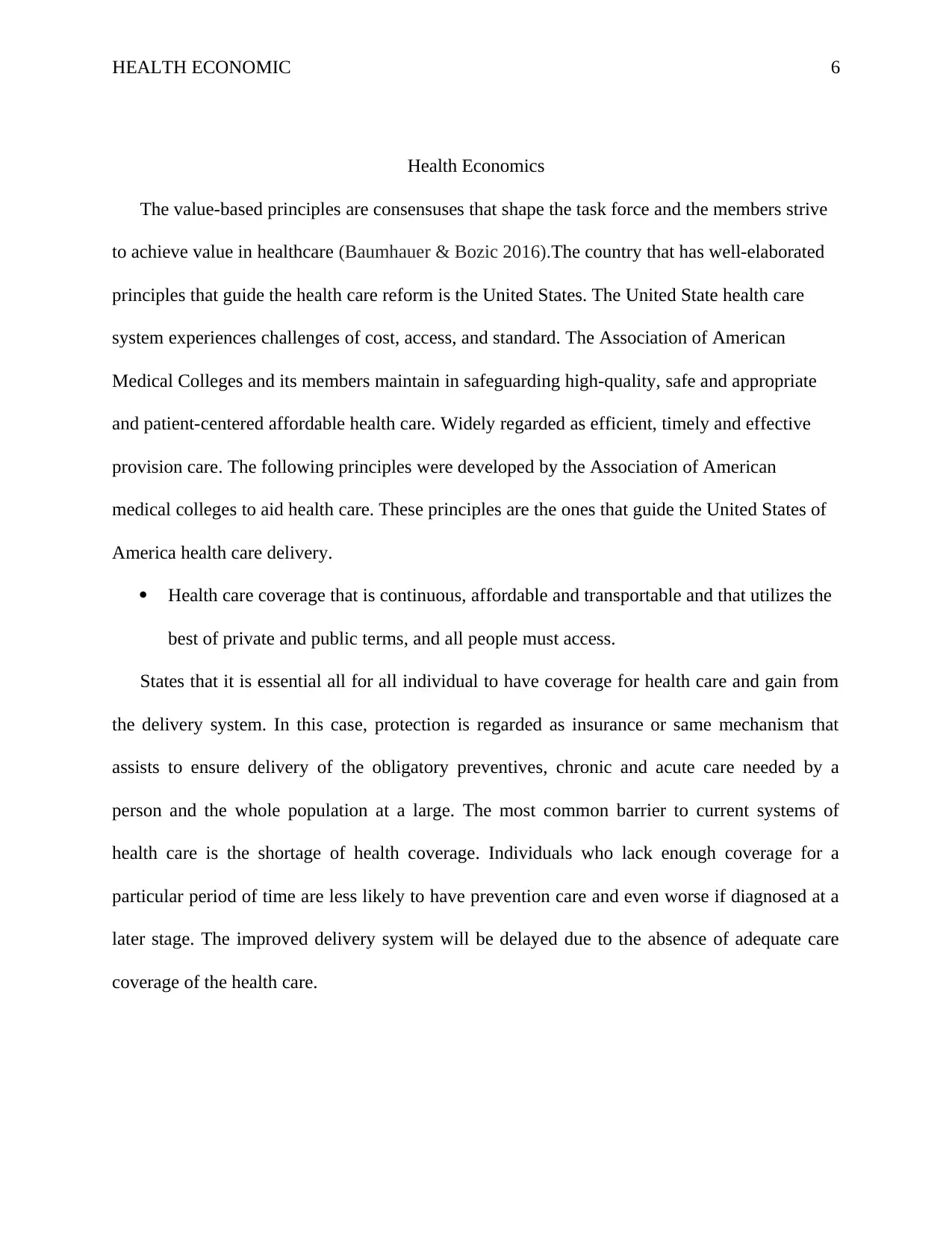
HEALTH ECONOMIC 6
Health Economics
The value-based principles are consensuses that shape the task force and the members strive
to achieve value in healthcare (Baumhauer & Bozic 2016).The country that has well-elaborated
principles that guide the health care reform is the United States. The United State health care
system experiences challenges of cost, access, and standard. The Association of American
Medical Colleges and its members maintain in safeguarding high-quality, safe and appropriate
and patient-centered affordable health care. Widely regarded as efficient, timely and effective
provision care. The following principles were developed by the Association of American
medical colleges to aid health care. These principles are the ones that guide the United States of
America health care delivery.
Health care coverage that is continuous, affordable and transportable and that utilizes the
best of private and public terms, and all people must access.
States that it is essential all for all individual to have coverage for health care and gain from
the delivery system. In this case, protection is regarded as insurance or same mechanism that
assists to ensure delivery of the obligatory preventives, chronic and acute care needed by a
person and the whole population at a large. The most common barrier to current systems of
health care is the shortage of health coverage. Individuals who lack enough coverage for a
particular period of time are less likely to have prevention care and even worse if diagnosed at a
later stage. The improved delivery system will be delayed due to the absence of adequate care
coverage of the health care.
Health Economics
The value-based principles are consensuses that shape the task force and the members strive
to achieve value in healthcare (Baumhauer & Bozic 2016).The country that has well-elaborated
principles that guide the health care reform is the United States. The United State health care
system experiences challenges of cost, access, and standard. The Association of American
Medical Colleges and its members maintain in safeguarding high-quality, safe and appropriate
and patient-centered affordable health care. Widely regarded as efficient, timely and effective
provision care. The following principles were developed by the Association of American
medical colleges to aid health care. These principles are the ones that guide the United States of
America health care delivery.
Health care coverage that is continuous, affordable and transportable and that utilizes the
best of private and public terms, and all people must access.
States that it is essential all for all individual to have coverage for health care and gain from
the delivery system. In this case, protection is regarded as insurance or same mechanism that
assists to ensure delivery of the obligatory preventives, chronic and acute care needed by a
person and the whole population at a large. The most common barrier to current systems of
health care is the shortage of health coverage. Individuals who lack enough coverage for a
particular period of time are less likely to have prevention care and even worse if diagnosed at a
later stage. The improved delivery system will be delayed due to the absence of adequate care
coverage of the health care.
⊘ This is a preview!⊘
Do you want full access?
Subscribe today to unlock all pages.

Trusted by 1+ million students worldwide
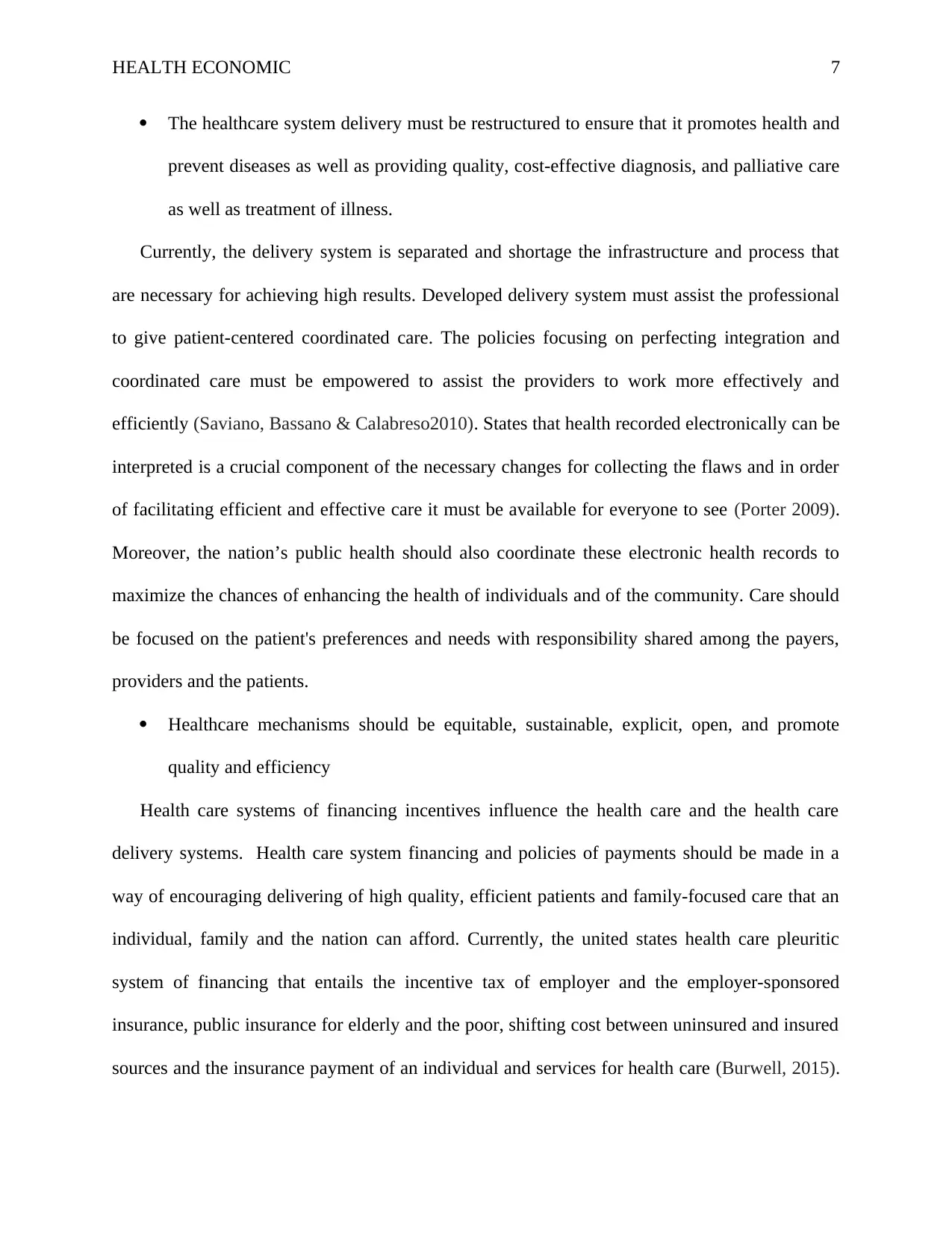
HEALTH ECONOMIC 7
The healthcare system delivery must be restructured to ensure that it promotes health and
prevent diseases as well as providing quality, cost-effective diagnosis, and palliative care
as well as treatment of illness.
Currently, the delivery system is separated and shortage the infrastructure and process that
are necessary for achieving high results. Developed delivery system must assist the professional
to give patient-centered coordinated care. The policies focusing on perfecting integration and
coordinated care must be empowered to assist the providers to work more effectively and
efficiently (Saviano, Bassano & Calabreso2010). States that health recorded electronically can be
interpreted is a crucial component of the necessary changes for collecting the flaws and in order
of facilitating efficient and effective care it must be available for everyone to see (Porter 2009).
Moreover, the nation’s public health should also coordinate these electronic health records to
maximize the chances of enhancing the health of individuals and of the community. Care should
be focused on the patient's preferences and needs with responsibility shared among the payers,
providers and the patients.
Healthcare mechanisms should be equitable, sustainable, explicit, open, and promote
quality and efficiency
Health care systems of financing incentives influence the health care and the health care
delivery systems. Health care system financing and policies of payments should be made in a
way of encouraging delivering of high quality, efficient patients and family-focused care that an
individual, family and the nation can afford. Currently, the united states health care pleuritic
system of financing that entails the incentive tax of employer and the employer-sponsored
insurance, public insurance for elderly and the poor, shifting cost between uninsured and insured
sources and the insurance payment of an individual and services for health care (Burwell, 2015).
The healthcare system delivery must be restructured to ensure that it promotes health and
prevent diseases as well as providing quality, cost-effective diagnosis, and palliative care
as well as treatment of illness.
Currently, the delivery system is separated and shortage the infrastructure and process that
are necessary for achieving high results. Developed delivery system must assist the professional
to give patient-centered coordinated care. The policies focusing on perfecting integration and
coordinated care must be empowered to assist the providers to work more effectively and
efficiently (Saviano, Bassano & Calabreso2010). States that health recorded electronically can be
interpreted is a crucial component of the necessary changes for collecting the flaws and in order
of facilitating efficient and effective care it must be available for everyone to see (Porter 2009).
Moreover, the nation’s public health should also coordinate these electronic health records to
maximize the chances of enhancing the health of individuals and of the community. Care should
be focused on the patient's preferences and needs with responsibility shared among the payers,
providers and the patients.
Healthcare mechanisms should be equitable, sustainable, explicit, open, and promote
quality and efficiency
Health care systems of financing incentives influence the health care and the health care
delivery systems. Health care system financing and policies of payments should be made in a
way of encouraging delivering of high quality, efficient patients and family-focused care that an
individual, family and the nation can afford. Currently, the united states health care pleuritic
system of financing that entails the incentive tax of employer and the employer-sponsored
insurance, public insurance for elderly and the poor, shifting cost between uninsured and insured
sources and the insurance payment of an individual and services for health care (Burwell, 2015).
Paraphrase This Document
Need a fresh take? Get an instant paraphrase of this document with our AI Paraphraser
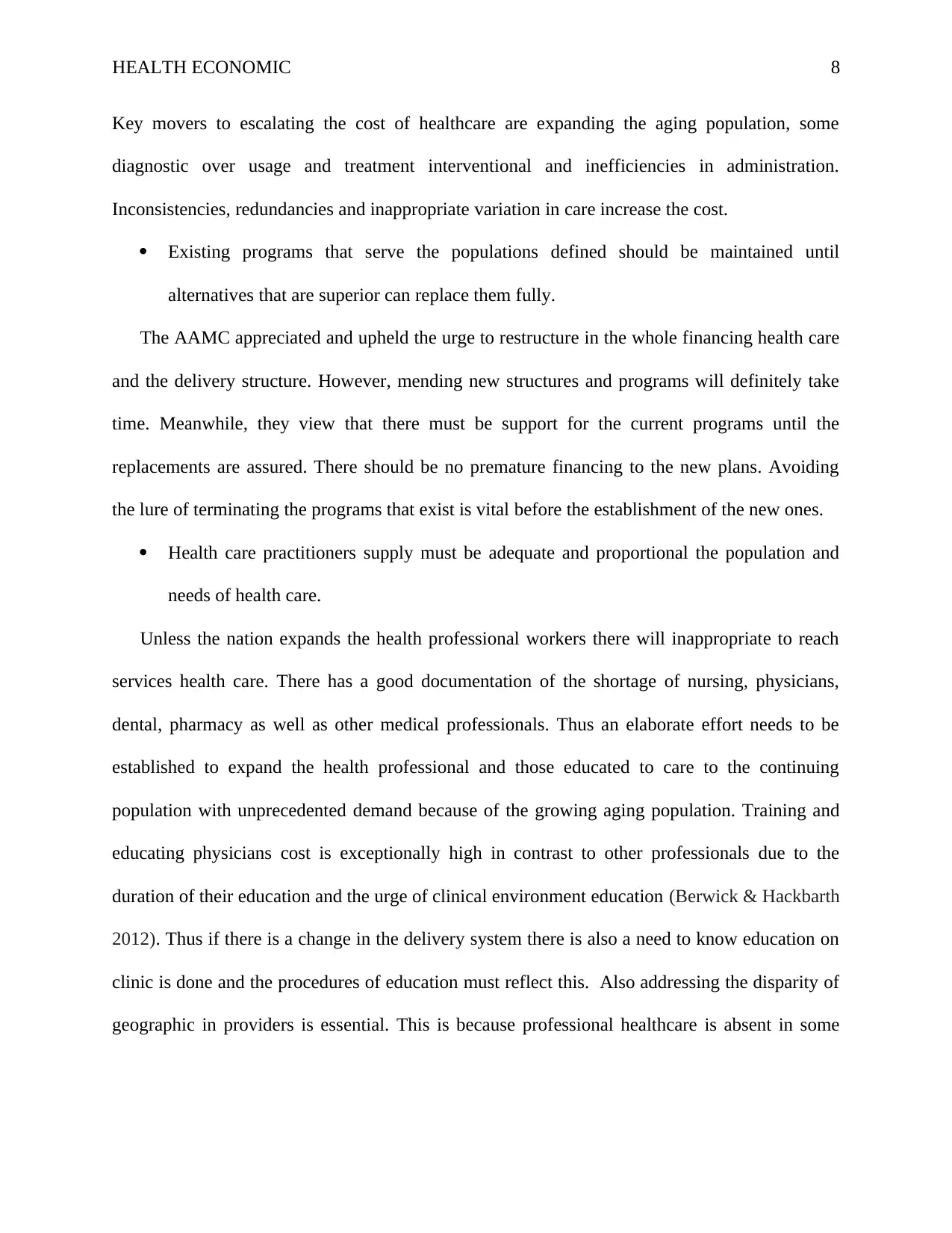
HEALTH ECONOMIC 8
Key movers to escalating the cost of healthcare are expanding the aging population, some
diagnostic over usage and treatment interventional and inefficiencies in administration.
Inconsistencies, redundancies and inappropriate variation in care increase the cost.
Existing programs that serve the populations defined should be maintained until
alternatives that are superior can replace them fully.
The AAMC appreciated and upheld the urge to restructure in the whole financing health care
and the delivery structure. However, mending new structures and programs will definitely take
time. Meanwhile, they view that there must be support for the current programs until the
replacements are assured. There should be no premature financing to the new plans. Avoiding
the lure of terminating the programs that exist is vital before the establishment of the new ones.
Health care practitioners supply must be adequate and proportional the population and
needs of health care.
Unless the nation expands the health professional workers there will inappropriate to reach
services health care. There has a good documentation of the shortage of nursing, physicians,
dental, pharmacy as well as other medical professionals. Thus an elaborate effort needs to be
established to expand the health professional and those educated to care to the continuing
population with unprecedented demand because of the growing aging population. Training and
educating physicians cost is exceptionally high in contrast to other professionals due to the
duration of their education and the urge of clinical environment education (Berwick & Hackbarth
2012). Thus if there is a change in the delivery system there is also a need to know education on
clinic is done and the procedures of education must reflect this. Also addressing the disparity of
geographic in providers is essential. This is because professional healthcare is absent in some
Key movers to escalating the cost of healthcare are expanding the aging population, some
diagnostic over usage and treatment interventional and inefficiencies in administration.
Inconsistencies, redundancies and inappropriate variation in care increase the cost.
Existing programs that serve the populations defined should be maintained until
alternatives that are superior can replace them fully.
The AAMC appreciated and upheld the urge to restructure in the whole financing health care
and the delivery structure. However, mending new structures and programs will definitely take
time. Meanwhile, they view that there must be support for the current programs until the
replacements are assured. There should be no premature financing to the new plans. Avoiding
the lure of terminating the programs that exist is vital before the establishment of the new ones.
Health care practitioners supply must be adequate and proportional the population and
needs of health care.
Unless the nation expands the health professional workers there will inappropriate to reach
services health care. There has a good documentation of the shortage of nursing, physicians,
dental, pharmacy as well as other medical professionals. Thus an elaborate effort needs to be
established to expand the health professional and those educated to care to the continuing
population with unprecedented demand because of the growing aging population. Training and
educating physicians cost is exceptionally high in contrast to other professionals due to the
duration of their education and the urge of clinical environment education (Berwick & Hackbarth
2012). Thus if there is a change in the delivery system there is also a need to know education on
clinic is done and the procedures of education must reflect this. Also addressing the disparity of
geographic in providers is essential. This is because professional healthcare is absent in some
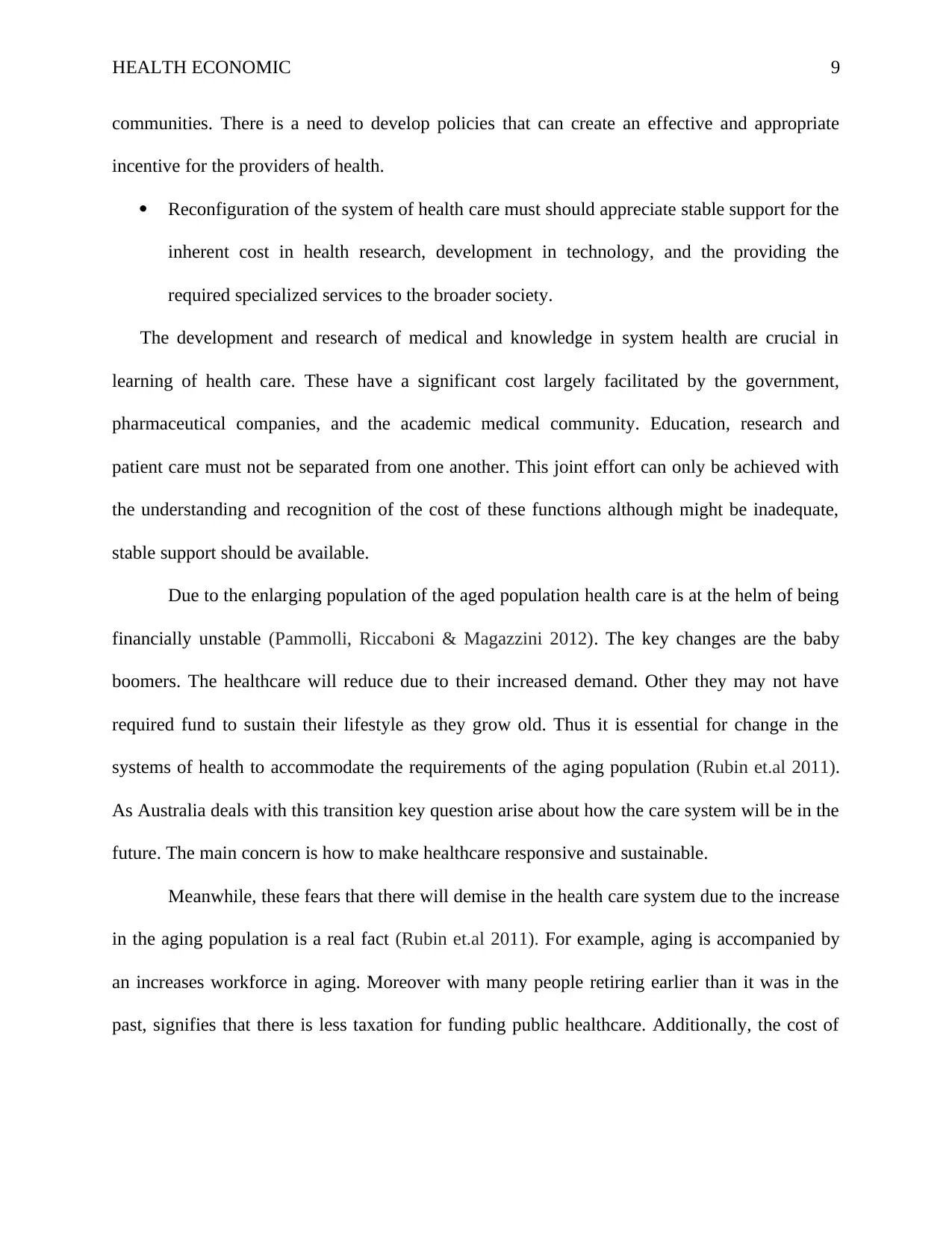
HEALTH ECONOMIC 9
communities. There is a need to develop policies that can create an effective and appropriate
incentive for the providers of health.
Reconfiguration of the system of health care must should appreciate stable support for the
inherent cost in health research, development in technology, and the providing the
required specialized services to the broader society.
The development and research of medical and knowledge in system health are crucial in
learning of health care. These have a significant cost largely facilitated by the government,
pharmaceutical companies, and the academic medical community. Education, research and
patient care must not be separated from one another. This joint effort can only be achieved with
the understanding and recognition of the cost of these functions although might be inadequate,
stable support should be available.
Due to the enlarging population of the aged population health care is at the helm of being
financially unstable (Pammolli, Riccaboni & Magazzini 2012). The key changes are the baby
boomers. The healthcare will reduce due to their increased demand. Other they may not have
required fund to sustain their lifestyle as they grow old. Thus it is essential for change in the
systems of health to accommodate the requirements of the aging population (Rubin et.al 2011).
As Australia deals with this transition key question arise about how the care system will be in the
future. The main concern is how to make healthcare responsive and sustainable.
Meanwhile, these fears that there will demise in the health care system due to the increase
in the aging population is a real fact (Rubin et.al 2011). For example, aging is accompanied by
an increases workforce in aging. Moreover with many people retiring earlier than it was in the
past, signifies that there is less taxation for funding public healthcare. Additionally, the cost of
communities. There is a need to develop policies that can create an effective and appropriate
incentive for the providers of health.
Reconfiguration of the system of health care must should appreciate stable support for the
inherent cost in health research, development in technology, and the providing the
required specialized services to the broader society.
The development and research of medical and knowledge in system health are crucial in
learning of health care. These have a significant cost largely facilitated by the government,
pharmaceutical companies, and the academic medical community. Education, research and
patient care must not be separated from one another. This joint effort can only be achieved with
the understanding and recognition of the cost of these functions although might be inadequate,
stable support should be available.
Due to the enlarging population of the aged population health care is at the helm of being
financially unstable (Pammolli, Riccaboni & Magazzini 2012). The key changes are the baby
boomers. The healthcare will reduce due to their increased demand. Other they may not have
required fund to sustain their lifestyle as they grow old. Thus it is essential for change in the
systems of health to accommodate the requirements of the aging population (Rubin et.al 2011).
As Australia deals with this transition key question arise about how the care system will be in the
future. The main concern is how to make healthcare responsive and sustainable.
Meanwhile, these fears that there will demise in the health care system due to the increase
in the aging population is a real fact (Rubin et.al 2011). For example, aging is accompanied by
an increases workforce in aging. Moreover with many people retiring earlier than it was in the
past, signifies that there is less taxation for funding public healthcare. Additionally, the cost of
⊘ This is a preview!⊘
Do you want full access?
Subscribe today to unlock all pages.

Trusted by 1+ million students worldwide
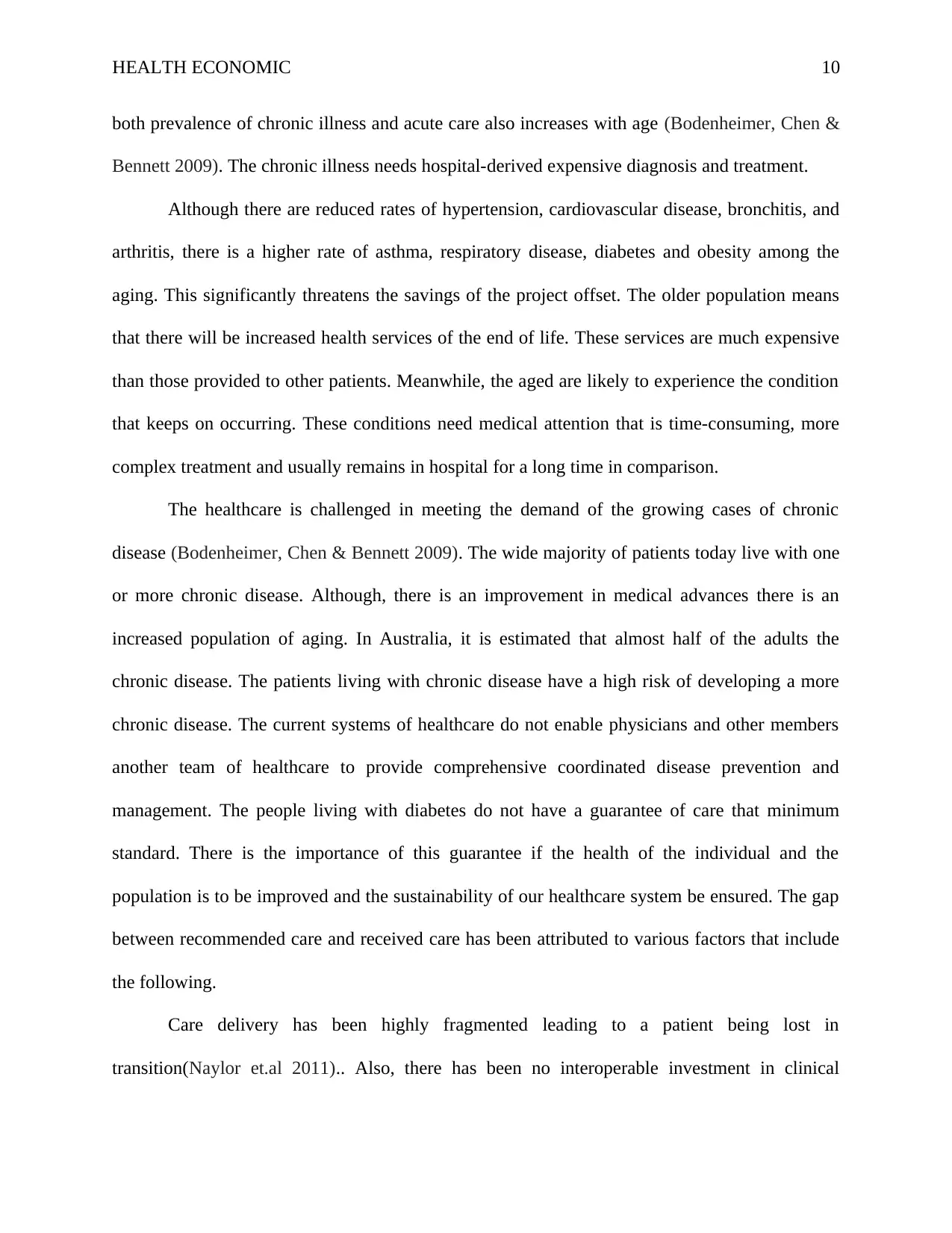
HEALTH ECONOMIC 10
both prevalence of chronic illness and acute care also increases with age (Bodenheimer, Chen &
Bennett 2009). The chronic illness needs hospital-derived expensive diagnosis and treatment.
Although there are reduced rates of hypertension, cardiovascular disease, bronchitis, and
arthritis, there is a higher rate of asthma, respiratory disease, diabetes and obesity among the
aging. This significantly threatens the savings of the project offset. The older population means
that there will be increased health services of the end of life. These services are much expensive
than those provided to other patients. Meanwhile, the aged are likely to experience the condition
that keeps on occurring. These conditions need medical attention that is time-consuming, more
complex treatment and usually remains in hospital for a long time in comparison.
The healthcare is challenged in meeting the demand of the growing cases of chronic
disease (Bodenheimer, Chen & Bennett 2009). The wide majority of patients today live with one
or more chronic disease. Although, there is an improvement in medical advances there is an
increased population of aging. In Australia, it is estimated that almost half of the adults the
chronic disease. The patients living with chronic disease have a high risk of developing a more
chronic disease. The current systems of healthcare do not enable physicians and other members
another team of healthcare to provide comprehensive coordinated disease prevention and
management. The people living with diabetes do not have a guarantee of care that minimum
standard. There is the importance of this guarantee if the health of the individual and the
population is to be improved and the sustainability of our healthcare system be ensured. The gap
between recommended care and received care has been attributed to various factors that include
the following.
Care delivery has been highly fragmented leading to a patient being lost in
transition(Naylor et.al 2011).. Also, there has been no interoperable investment in clinical
both prevalence of chronic illness and acute care also increases with age (Bodenheimer, Chen &
Bennett 2009). The chronic illness needs hospital-derived expensive diagnosis and treatment.
Although there are reduced rates of hypertension, cardiovascular disease, bronchitis, and
arthritis, there is a higher rate of asthma, respiratory disease, diabetes and obesity among the
aging. This significantly threatens the savings of the project offset. The older population means
that there will be increased health services of the end of life. These services are much expensive
than those provided to other patients. Meanwhile, the aged are likely to experience the condition
that keeps on occurring. These conditions need medical attention that is time-consuming, more
complex treatment and usually remains in hospital for a long time in comparison.
The healthcare is challenged in meeting the demand of the growing cases of chronic
disease (Bodenheimer, Chen & Bennett 2009). The wide majority of patients today live with one
or more chronic disease. Although, there is an improvement in medical advances there is an
increased population of aging. In Australia, it is estimated that almost half of the adults the
chronic disease. The patients living with chronic disease have a high risk of developing a more
chronic disease. The current systems of healthcare do not enable physicians and other members
another team of healthcare to provide comprehensive coordinated disease prevention and
management. The people living with diabetes do not have a guarantee of care that minimum
standard. There is the importance of this guarantee if the health of the individual and the
population is to be improved and the sustainability of our healthcare system be ensured. The gap
between recommended care and received care has been attributed to various factors that include
the following.
Care delivery has been highly fragmented leading to a patient being lost in
transition(Naylor et.al 2011).. Also, there has been no interoperable investment in clinical
Paraphrase This Document
Need a fresh take? Get an instant paraphrase of this document with our AI Paraphraser
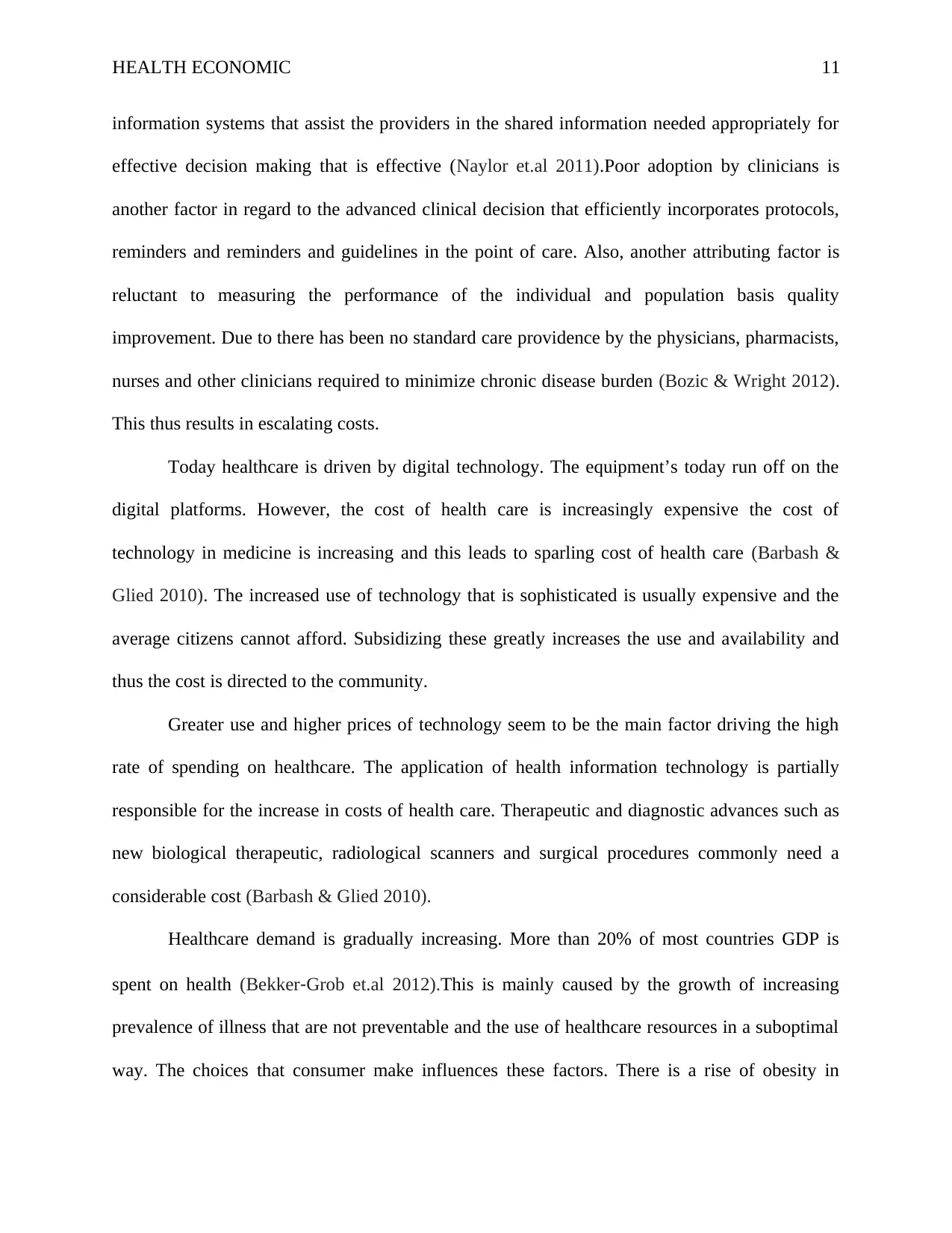
HEALTH ECONOMIC 11
information systems that assist the providers in the shared information needed appropriately for
effective decision making that is effective (Naylor et.al 2011).Poor adoption by clinicians is
another factor in regard to the advanced clinical decision that efficiently incorporates protocols,
reminders and reminders and guidelines in the point of care. Also, another attributing factor is
reluctant to measuring the performance of the individual and population basis quality
improvement. Due to there has been no standard care providence by the physicians, pharmacists,
nurses and other clinicians required to minimize chronic disease burden (Bozic & Wright 2012).
This thus results in escalating costs.
Today healthcare is driven by digital technology. The equipment’s today run off on the
digital platforms. However, the cost of health care is increasingly expensive the cost of
technology in medicine is increasing and this leads to sparling cost of health care (Barbash &
Glied 2010). The increased use of technology that is sophisticated is usually expensive and the
average citizens cannot afford. Subsidizing these greatly increases the use and availability and
thus the cost is directed to the community.
Greater use and higher prices of technology seem to be the main factor driving the high
rate of spending on healthcare. The application of health information technology is partially
responsible for the increase in costs of health care. Therapeutic and diagnostic advances such as
new biological therapeutic, radiological scanners and surgical procedures commonly need a
considerable cost (Barbash & Glied 2010).
Healthcare demand is gradually increasing. More than 20% of most countries GDP is
spent on health (Bekker‐Grob et.al 2012).This is mainly caused by the growth of increasing
prevalence of illness that are not preventable and the use of healthcare resources in a suboptimal
way. The choices that consumer make influences these factors. There is a rise of obesity in
information systems that assist the providers in the shared information needed appropriately for
effective decision making that is effective (Naylor et.al 2011).Poor adoption by clinicians is
another factor in regard to the advanced clinical decision that efficiently incorporates protocols,
reminders and reminders and guidelines in the point of care. Also, another attributing factor is
reluctant to measuring the performance of the individual and population basis quality
improvement. Due to there has been no standard care providence by the physicians, pharmacists,
nurses and other clinicians required to minimize chronic disease burden (Bozic & Wright 2012).
This thus results in escalating costs.
Today healthcare is driven by digital technology. The equipment’s today run off on the
digital platforms. However, the cost of health care is increasingly expensive the cost of
technology in medicine is increasing and this leads to sparling cost of health care (Barbash &
Glied 2010). The increased use of technology that is sophisticated is usually expensive and the
average citizens cannot afford. Subsidizing these greatly increases the use and availability and
thus the cost is directed to the community.
Greater use and higher prices of technology seem to be the main factor driving the high
rate of spending on healthcare. The application of health information technology is partially
responsible for the increase in costs of health care. Therapeutic and diagnostic advances such as
new biological therapeutic, radiological scanners and surgical procedures commonly need a
considerable cost (Barbash & Glied 2010).
Healthcare demand is gradually increasing. More than 20% of most countries GDP is
spent on health (Bekker‐Grob et.al 2012).This is mainly caused by the growth of increasing
prevalence of illness that are not preventable and the use of healthcare resources in a suboptimal
way. The choices that consumer make influences these factors. There is a rise of obesity in
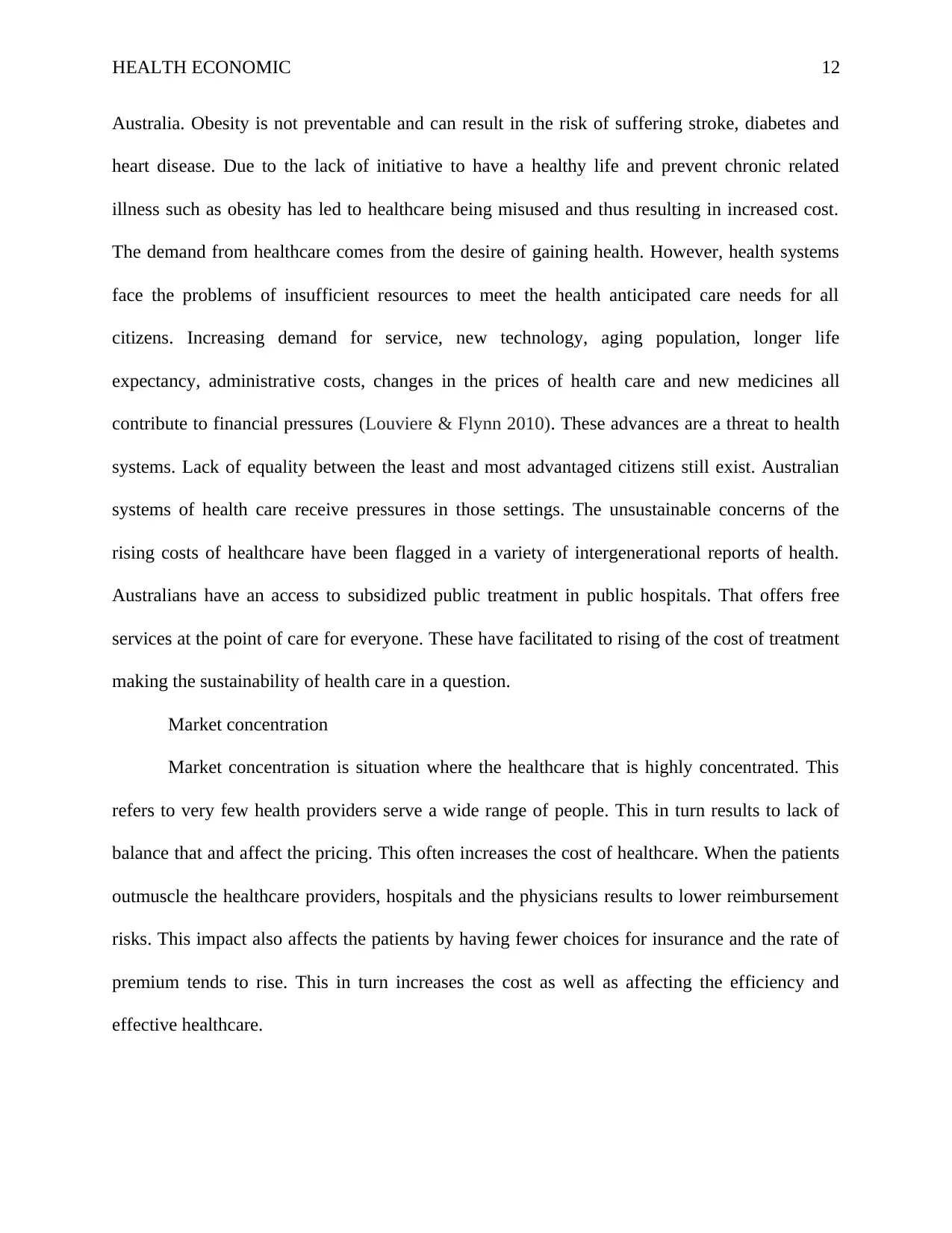
HEALTH ECONOMIC 12
Australia. Obesity is not preventable and can result in the risk of suffering stroke, diabetes and
heart disease. Due to the lack of initiative to have a healthy life and prevent chronic related
illness such as obesity has led to healthcare being misused and thus resulting in increased cost.
The demand from healthcare comes from the desire of gaining health. However, health systems
face the problems of insufficient resources to meet the health anticipated care needs for all
citizens. Increasing demand for service, new technology, aging population, longer life
expectancy, administrative costs, changes in the prices of health care and new medicines all
contribute to financial pressures (Louviere & Flynn 2010). These advances are a threat to health
systems. Lack of equality between the least and most advantaged citizens still exist. Australian
systems of health care receive pressures in those settings. The unsustainable concerns of the
rising costs of healthcare have been flagged in a variety of intergenerational reports of health.
Australians have an access to subsidized public treatment in public hospitals. That offers free
services at the point of care for everyone. These have facilitated to rising of the cost of treatment
making the sustainability of health care in a question.
Market concentration
Market concentration is situation where the healthcare that is highly concentrated. This
refers to very few health providers serve a wide range of people. This in turn results to lack of
balance that and affect the pricing. This often increases the cost of healthcare. When the patients
outmuscle the healthcare providers, hospitals and the physicians results to lower reimbursement
risks. This impact also affects the patients by having fewer choices for insurance and the rate of
premium tends to rise. This in turn increases the cost as well as affecting the efficiency and
effective healthcare.
Australia. Obesity is not preventable and can result in the risk of suffering stroke, diabetes and
heart disease. Due to the lack of initiative to have a healthy life and prevent chronic related
illness such as obesity has led to healthcare being misused and thus resulting in increased cost.
The demand from healthcare comes from the desire of gaining health. However, health systems
face the problems of insufficient resources to meet the health anticipated care needs for all
citizens. Increasing demand for service, new technology, aging population, longer life
expectancy, administrative costs, changes in the prices of health care and new medicines all
contribute to financial pressures (Louviere & Flynn 2010). These advances are a threat to health
systems. Lack of equality between the least and most advantaged citizens still exist. Australian
systems of health care receive pressures in those settings. The unsustainable concerns of the
rising costs of healthcare have been flagged in a variety of intergenerational reports of health.
Australians have an access to subsidized public treatment in public hospitals. That offers free
services at the point of care for everyone. These have facilitated to rising of the cost of treatment
making the sustainability of health care in a question.
Market concentration
Market concentration is situation where the healthcare that is highly concentrated. This
refers to very few health providers serve a wide range of people. This in turn results to lack of
balance that and affect the pricing. This often increases the cost of healthcare. When the patients
outmuscle the healthcare providers, hospitals and the physicians results to lower reimbursement
risks. This impact also affects the patients by having fewer choices for insurance and the rate of
premium tends to rise. This in turn increases the cost as well as affecting the efficiency and
effective healthcare.
⊘ This is a preview!⊘
Do you want full access?
Subscribe today to unlock all pages.

Trusted by 1+ million students worldwide
1 out of 20
Related Documents
Your All-in-One AI-Powered Toolkit for Academic Success.
+13062052269
info@desklib.com
Available 24*7 on WhatsApp / Email
![[object Object]](/_next/static/media/star-bottom.7253800d.svg)
Unlock your academic potential
Copyright © 2020–2025 A2Z Services. All Rights Reserved. Developed and managed by ZUCOL.




